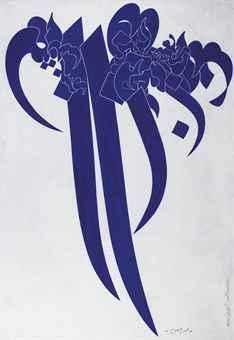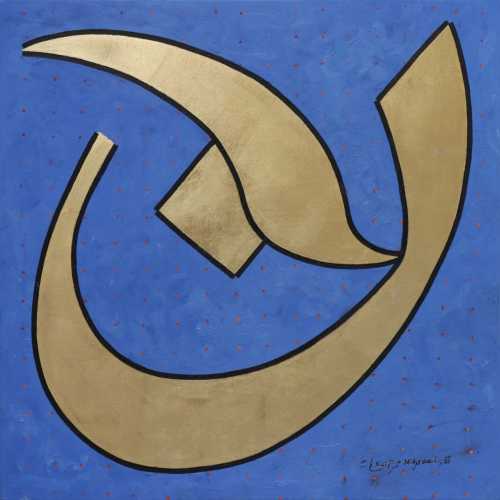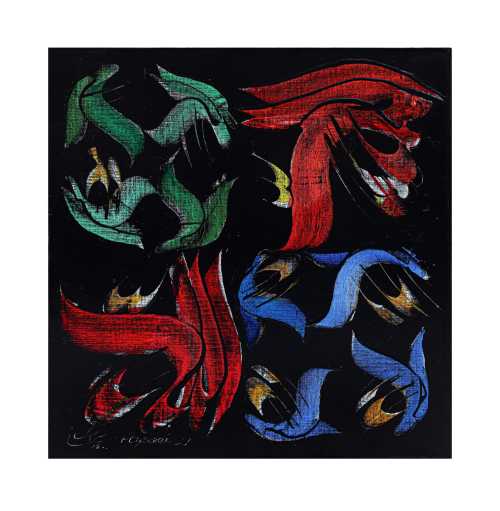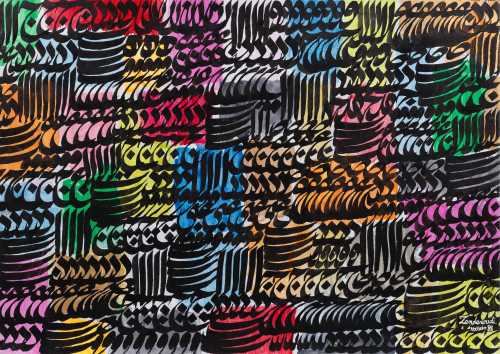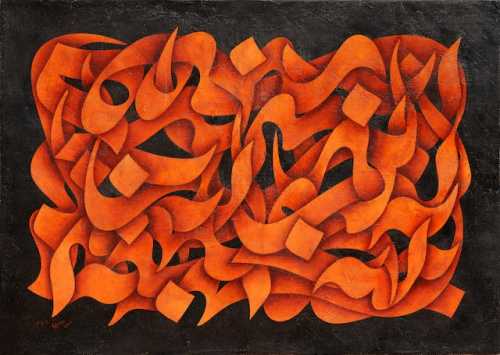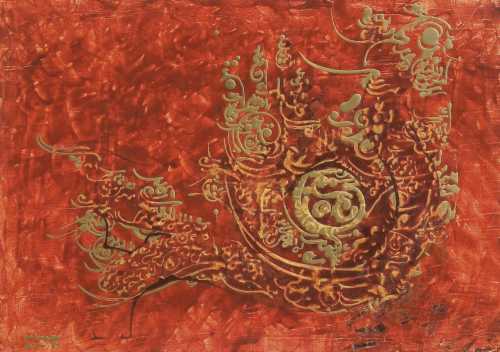- Bismillahe Rahmane Rahim 1990
- Acrylic on cardboard
- Painting, Calligraphy Painting
- 99.4 * 69.4 cm
- signed and dated in Farsi (lower right)
Artwork Description
The letter 'Ba' is derived from 'Baha'a-Allah', the Splendour of Allah.
The letter 'Seen' is derived from 'Sumu'-Allah', the Majesty of Allah. The letter 'Meem' is derived from 'Mulku-Allah', the Kingdom of Allah. 'Allah' is the God of everything.
'Ar Rahman' is the One Who is Merciful to all His creation.
'Ar Rahim' is the One Who singles out those who believe in Him to
receive the greatest share of His mercy.
Fusing his Iranian cultural heritage with his own creative ideas, Mohammed Ehsai was inspired by religious texts. In some of his works such as the present lot, the artist detaches the words as he intends to intensify their artistic power. The balance and harmony of his work are found in the sentence he has chosen as the subject of his composition.
Ehsai's work is considered amongst the most important in terms of calligraphy in contemporary Iranian art. He is best known for his combination of the traditional techniques with a modern style of graphic arts, which he fuses into an innovative artistic form.
Ehsai's aesthetic language inspired by various international art movements is unique as the artist transforms the traditional Persian script into pure abstraction.
His works fall under the art of 'Letterism' and can be distinguished as two categories: the 'calligraphy-paintings', which are influenced by structural calculation and by the traditional writings observed in the Islamic architecture and the 'eternal alphabet' in which free-flowing brushstrokes give the painting a faster rhythm.
The present work perfectly combines both styles, yet adds a third dimension to it as the words and the letters become shape.
The beautiful floating composition alike a flower bouquet represents the holy sentence 'Bismillahe Rahmane Al Rahim' recited before any verse from the Holy Quran. The verse means 'In the Name of Allah, the Most Beneficent, the most Merciful' and appears 114 times in the Holy Quran.
The words Rahman and Rahim are essentially from the same root and mean mercy or grace, yet in their application, they refer to a different aspect of Allah's mercy.
He is 'Rahman' to all His creation, whether they be obedient to Him or disobedient.
He is 'Rahim' to the faithful believers who do good and receive His mercy as a reward, both in this world and the next.
Ehsai's work appears as elongated flower stems, in a majectic royal blue and set on a pure background. The thoughtful selection of angles and cohesion of lines emphasizes on the beauty of the word, allowing the holy sentence to emerge once all elements of the work bond. Ehsai's decorative style in this work is fused with elegance and mysticism.
Most of Ehsai's paintings include two colours, a limitation the artist implements on most of his works. This reduction of colours gives his work a monumental effect. In Bismillahe Rahmane Rahim, the use of the royal blue reminds us of the tiles seen in the Persian and Islamic architecture since centuries.
The significance of this work lies in its ability to create a powerful abstract form through the use of letter and line. The distribution of the letters in the form of a bouquet is indicative of a supreme order of an utopian idealism within religion.
The letter 'Seen' is derived from 'Sumu'-Allah', the Majesty of Allah. The letter 'Meem' is derived from 'Mulku-Allah', the Kingdom of Allah. 'Allah' is the God of everything.
'Ar Rahman' is the One Who is Merciful to all His creation.
'Ar Rahim' is the One Who singles out those who believe in Him to
receive the greatest share of His mercy.
Fusing his Iranian cultural heritage with his own creative ideas, Mohammed Ehsai was inspired by religious texts. In some of his works such as the present lot, the artist detaches the words as he intends to intensify their artistic power. The balance and harmony of his work are found in the sentence he has chosen as the subject of his composition.
Ehsai's work is considered amongst the most important in terms of calligraphy in contemporary Iranian art. He is best known for his combination of the traditional techniques with a modern style of graphic arts, which he fuses into an innovative artistic form.
Ehsai's aesthetic language inspired by various international art movements is unique as the artist transforms the traditional Persian script into pure abstraction.
His works fall under the art of 'Letterism' and can be distinguished as two categories: the 'calligraphy-paintings', which are influenced by structural calculation and by the traditional writings observed in the Islamic architecture and the 'eternal alphabet' in which free-flowing brushstrokes give the painting a faster rhythm.
The present work perfectly combines both styles, yet adds a third dimension to it as the words and the letters become shape.
The beautiful floating composition alike a flower bouquet represents the holy sentence 'Bismillahe Rahmane Al Rahim' recited before any verse from the Holy Quran. The verse means 'In the Name of Allah, the Most Beneficent, the most Merciful' and appears 114 times in the Holy Quran.
The words Rahman and Rahim are essentially from the same root and mean mercy or grace, yet in their application, they refer to a different aspect of Allah's mercy.
He is 'Rahman' to all His creation, whether they be obedient to Him or disobedient.
He is 'Rahim' to the faithful believers who do good and receive His mercy as a reward, both in this world and the next.
Ehsai's work appears as elongated flower stems, in a majectic royal blue and set on a pure background. The thoughtful selection of angles and cohesion of lines emphasizes on the beauty of the word, allowing the holy sentence to emerge once all elements of the work bond. Ehsai's decorative style in this work is fused with elegance and mysticism.
Most of Ehsai's paintings include two colours, a limitation the artist implements on most of his works. This reduction of colours gives his work a monumental effect. In Bismillahe Rahmane Rahim, the use of the royal blue reminds us of the tiles seen in the Persian and Islamic architecture since centuries.
The significance of this work lies in its ability to create a powerful abstract form through the use of letter and line. The distribution of the letters in the form of a bouquet is indicative of a supreme order of an utopian idealism within religion.
More lots by Mohammad Ehsai
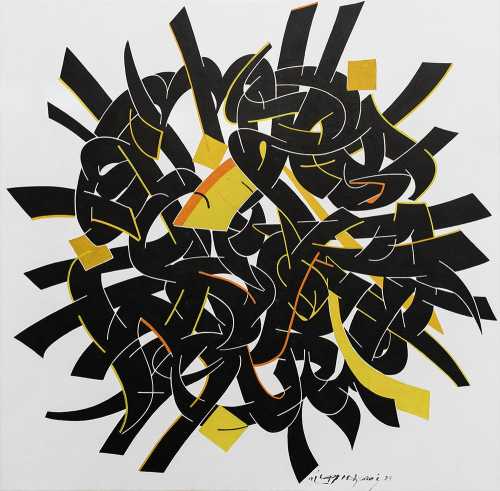
The Autumn of Sunflower
Estimation
20,000,000,000﷼
40,000 USD
-
30,000,000,000﷼
60,000 USD
Realized Price
41,800,000,000﷼
83,600 USD
67.2%
Sale Date
Tehran
-
12 December 2023
Realized Price
122,038 USD
Min Estimate
72,125 USD
Max Estimate
101,716 USD
Average Artwork Worth
+62.555%
Average Growth of Artwork Worth
Sales Performance Against Estimates
Average & Median Sold Lot Value
2021 - 2025
Performance vs. Estimate
2021 - 2025
Sell-through Rate
2021 - 2025
